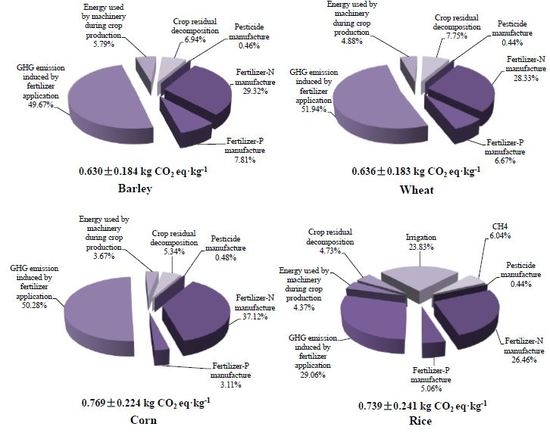Carbon Footprint and Driving Forces of Saline Agriculture in Coastally Reclaimed Areas of Eastern China: A Survey of Four Staple Crops
Abstract
:1. Introduction
2. Materials and Methods
2.1. Study Area and Data Acquisition
2.2. Methodology
2.2.1. Setting Goals and Identifying the Boundary of LCA
2.2.2. Input Inventory Analysis
2.2.3. Metrics of Carbon Footprints
3. Results
3.1. Area-Derived CF of Saline Agricultural Productions
3.2. Yield-Derived CF of Saline Agricultural Productions
3.3. Driving Forces of Saline Agricultural CF
4. Discussion
4.1. Comparison with Similar Studies
4.2. Structure and Driving Forces of Grain CF in Saline Agriculture
4.3. Methods for Reducing CF of Saline Agriculture
5. Conclusions
Acknowledgments
Author Contributions
Conflicts of Interest
References
- Edenhofer, O. Climate Change 2014—Mitigation of Climate Change: Key Insights from IPCC’s AR5 and beyond; Cambridge University Press: Cambridge, UK, 2015. [Google Scholar]
- Pryor, S.W.; Smithers, J.; Lyne, P.; Antwerpen, R.V. Impact of agricultural practices on energy use and greenhouse gas emissions for South African sugarcane production. J. Clean. Prod. 2017, 141, 137–145. [Google Scholar] [CrossRef]
- Zhang, D.; Shen, J.; Zhang, F.; Li, Y.E.; Zhang, W. Carbon footprint of grain production in China. Sci. Rep. 2017, 7, 4126. [Google Scholar] [CrossRef] [PubMed]
- Lin, E.; Liu, Y.; Li, Y. Agricultural C cycle and greenhouse gas emission in China. Nutr. Cycl. Agroecosyst. 1997, 49, 295–299. [Google Scholar]
- Sun, Z.; Sun, W.; Tong, C.; Zeng, C.; Yu, X.; Mou, X. China’s coastal wetlands: Conservation history, implementation efforts, existing issues and strategies for future improvement. Environ. Int. 2015, 79, 25–41. [Google Scholar] [CrossRef] [PubMed]
- Li, J.; Pu, L.; Han, M.; Zhu, M.; Zhang, R.; Xiang, Y. Soil salinization research in China: Advances and prospects. J. Geogr. Sci. 2014, 24, 943–960. [Google Scholar] [CrossRef]
- Li, J.; Pu, L.; Zhu, M.; Zhang, J.; Li, P.; Dai, X.; Xu, Y.; Liu, L. Evolution of soil properties following reclamation in coastal areas: A review. Geoderma 2014, 226–227, 130–139. [Google Scholar] [CrossRef]
- Chambers, J.Q.; Fisher, J.I.; Zeng, H.; Chapman, E.L.; Baker, D.B.; Hurtt, G.C. Hurricane Katrina’s carbon footprint on U.S. Gulf Coast forests. Science 2007, 318, 1107. [Google Scholar] [PubMed]
- Mogensen, L.; Kristensen, T.; Nguyen, T.L.T.; Knudsen, M.T.; Hermansen, J.E. Method for calculating carbon footprint of cattle feeds—Including contribution from soil carbon changes and use of cattle manure. J. Clean. Prod. 2014, 73, 40–51. [Google Scholar] [CrossRef]
- Duan, H.; Yue, Z.; Zhao, J.; Bian, X. Carbon Footprint Analysis of Farmland Ecosystem in China. J. Soil Water Conserv. 2011, 25, 203–208. (In Chinese) [Google Scholar]
- Al-Mansour, F.; Jejcic, V. A model calculation of the carbon footprint of agricultural products: The case of Slovenia. Energy 2017, 137, 7–15. [Google Scholar] [CrossRef]
- Han, Y.; Chen, K.; Chen, Y.; Su, M.; Chen, L. Study on Dynamic Change of Carbon Footprint of Qinghai in the Years from 1999 to 2008. Ecol. Econ. 2011, 235, 54–56. (In Chinese) [Google Scholar]
- Hillier, J.; Hawes, C.; Squire, G.; Hilton, A.; Wale, S.; Smith, P. The carbon footprints of food crop production. Int. J. Agric. Sustain. 2009, 7, 107–118. [Google Scholar] [CrossRef]
- Dong, G.; Mao, X.; Zhou, J.; Zeng, A. Carbon footprint accounting and dynamics and the driving forces of agricultural production in Zhejiang Province, China. Ecol. Econ. 2013, 91, 38–47. [Google Scholar] [CrossRef]
- Gan, Y.; Liang, C.; Chai, Q.; Lemke, R.L.; Campbell, C.A.; Zentner, R.P. Improving farming practices reduces the carbon footprint of spring wheat production. Nat. Commun. 2014, 5, 5012. [Google Scholar] [CrossRef] [PubMed]
- Bailey, A.P.; Basford, W.D.; Penlington, N.; Park, J.R.; Keatinge, J.D.H.; Rehman, T.; Tranter, R.B.; Yates, C.M. A comparison of energy use in conventional and integrated arable farming systems in the UK. Agric. Ecosyst. Environ. 2003, 97, 241–253. [Google Scholar] [CrossRef]
- Gan, Y.; Liang, C.; Hamel, C.; Cutforth, H.; Wang, H. Strategies for reducing the carbon footprint of field crops for semiarid areas. A review. Agron. Sustain. Dev. 2011, 31, 643–656. [Google Scholar] [CrossRef]
- Karimi, P.; Qureshi, A.S.; Bahramloo, R.; Molden, D. Reducing carbon emissions through improved irrigation and groundwater management: A case study from Iran. Agric. Water Manag. 2012, 108, 52–60. [Google Scholar] [CrossRef]
- Wang, Z.B.; Wang, M.; Chen, F. Carbon Footprint Analysis of Crop Production in North China Plain. Sci. Agric. Sin. 2015, 48, 83–92. (In Chinese) [Google Scholar]
- Liu, S.; Wang, X.; Cui, L.; Duan, X.; Zhao, J. Carbon footprint and its impact factors of feed crops in Guanzhong Plain. Acta Sci. Circumstantiae 2017, 37, 1201–1208. (In Chinese) [Google Scholar]
- Liu, X.; Xu, W.; Li, Z.; Chu, Q.; Yang, X.; Chen, F. The missteps, improvement and application of carbon footprint methodology in farmland ecosystems with the case study of analyzing the carbon efficiency of China's intensive farming. Chin. J. Agric. Resour. Reg. Plan. 2013, 34, 1–7. (In Chinese) [Google Scholar]
- Leigang, S.; Chen, F.; Kong, F.; Fan, S. The carbon footprint of winter wheat-summer maize cropping pattern on north china plain. China Popul. Resour. Environ. 2011, 21, 97–102. (In Chinese) [Google Scholar]
- Dubey, A.; Lal, R. Carbon footprint and sustainability of agricultural production systems in Punjab, India, and Ohio, USA. J. Crop Improv. 2009, 23, 332–350. [Google Scholar] [CrossRef]
- Huang, X.M.; Chen, C.Q.; Chen, M.Z.; Song, Z.W.; Deng, A.X.; Zhang, J.; Zheng, C.Y.; Zhang, W.J. Carbon footprints of major staple grain crops production in three provinces of Northeast China during 2004–2013. Chin. J. Appl. Ecol. 2016, 27, 3307–3315. (In Chinese) [Google Scholar]
- Li, J.; Wang, W.; Pu, L.; Liu, L.; Zhang, Z.; Li, Q. Coastal reclamation and saltmarsh carbon budget: Advances and prospects. Adv. Earth Sci. 2017, 32, 599–614. (In Chinese) [Google Scholar] [CrossRef]
- Yan, M.; Luo, T.; Bian, R.; Cheng, K.; Pan, G.; Rees, R. A comparative study on carbon footprint of rice production between household and aggregated farms from Jiangxi, China. Environ. Monit. Assess. 2015, 187, 1–13. [Google Scholar] [CrossRef] [PubMed]
- Li, J.; Pu, L.; Ming, Z.; Dai, X.; Yan, X.; Chen, X.; Zhang, L.; Zhang, R. Monitoring soil salt content using HJ-1A hyperspectral data: A case study of coastal areas in Rudong County, Eastern China. Chin. Geogr. Sci. 2015, 25, 213–223. [Google Scholar] [CrossRef]
- Knudsen, M.T.; Meyeraurich, A.; Olesen, J.E.; Chirinda, N.; Hermansen, J.E. Carbon footprints of crops from organic and conventional arable crop rotations—Using a life cycle assessment approach. J. Clean. Prod. 2014, 64, 609–618. [Google Scholar] [CrossRef]
- Stocker, T.F.; Qin, D.; Plattner, G.K.; Alexander, L.V.; Allen, S.K.; Bindoff, N.L.; Bréon, F.M.; Church, J.A.; Cubasch, U.; Emori, S. IPCC, 2013: Technical Summary. In Climate Change 2013: The Physical Science Basis. Contribution of Working Group I to the Fifth Assessment Report of the Intergovernmental Panel on Climate Change; Stocker, T.F.D., Qin, G.-K., Plattner, M., Tignor, S.K., Eds.; Cambridge University Press: Cambridge, UK, 2013; pp. 533–535. [Google Scholar]
- Weidema, B.; Bauer, C.; Hischier, R.; Mutel, C.L.; Nemecek, T.; Reinhard, J.; Vadenbo, C.O.; Wernet, G. Data Quality Guidelines for the Ecoinvent Database Version 3: Overview and Methdology (Final); The Ecoinvent Centre: St. Gallen, Switzerland, 2013. [Google Scholar]
- West, T.O.; Marland, G. A synthesis of carbon sequestration, carbon emissions, and net carbon flux in agriculture: Comparing tillage practices in the United States. Agric. Ecosyst. Environ. 2002, 91, 217–232. [Google Scholar] [CrossRef]
- Xie, H. Improvement and Application of Ecological Footprint Evaluation Model; Chemical Industry Press: Beijing, China, 2008. [Google Scholar]
- Di, X.; Nie, Z.; Yuan, B.; Zuo, T. Life cycle inventory for electricity generation in China. Int. J. Life Cycle Assess. 2007, 12, 217–224. [Google Scholar] [CrossRef]
- Miao, R.; Zhang, F.; Li, L. Analysis of biomass and nitrogen content in the ground and underground of maize/broad bean, wheat/broad bean and barley/broad bean intercropping system. Chin. Agric. Sci. Bull. 2008, 24, 148–152. (In Chinese) [Google Scholar]
- Xue, L.; Yang, L.; Fan, X. Estimation of nitrogen content and C/N in rice leaves and plant with canopy reflectance spectra. Acta Agron. Sin. 2006, 59, 289–302. (In Chinese) [Google Scholar]
- Law, Y.; Ye, L.; Pan, Y.; Yuan, Z. Nitrous oxide emissions from wastewater treatment processes. Philos. Trans. R. Soc. Lond. 2012, 367, 1265–1277. [Google Scholar] [CrossRef] [PubMed]
- Yoshikawa, N.; Ikeda, T.; Amano, K.; Shimada, K. Carbon Footprint Estimation and Data Sampling Method: A Case Study of Ecologically Cultivated Rice Produced in Japan. In Proceedings of the VII International Conference on Life Cycle Assessment in the Agri-Food Sector, Bari, Italy, 22–24 September 2010. [Google Scholar]
- Pandey, D.; Agrawal, M.; Pandey, J.S. Carbon footprint: Current methods of estimation. Environ. Monit. Assess. 2011, 178, 135–178. [Google Scholar] [CrossRef] [PubMed]
- Adom, F.; Maes, A.; Workman, C.; Clayton-Nierderman, Z.; Thoma, G.; Shonnard, D. Regional carbon footprint analysis of dairy feeds for milk production in the USA. Int. J. Life Cycle Assess. 2012, 17, 520–534. [Google Scholar] [CrossRef]
- Brock, P.; Madden, P.; Schwenke, G.; Herridge, D. Greenhouse Gas Emissions Profile for 1 Tonne of Wheat Produced in Central Zone (East) New South Wales: A Life Cycle Assessment Approach; The Society: London, UK, 2012; pp. 78–85. [Google Scholar]
- Baek, C.Y.; Lee, K.M.; Park, K.H. Quantification and control of the greenhouse gas emissions from a dairy cow system. J. Clean. Prod. 2014, 70, 50–60. [Google Scholar] [CrossRef]
- Wu, N.; Wang, E.; Wang, C.; Ning, T.; Li, Y.; Zhou, C. Effects of tillage on carbon footprint of wheat-corn two cropped farmland ecosystem. Shandong Agric. Sci. 2017, 49, 34–40. (In Chinese) [Google Scholar]
- Cao, L.; Li, M.; Wang, X.; Zhao, Z.; Pan, X. Life cycle assessment of carbon footprint for rice production in Shanghai. Acta Ecol. Sin. 2014, 34, 491–499. (In Chinese) [Google Scholar]
- Cui, Z.; Zhang, H.; Chen, X.; Zhang, C.; Ma, W.; Huang, C.; Zhang, W.; Mi, G.; Miao, Y.; Li, X.; et al. Pursuing sustainable productivity with millions of smallholder farmers. Nature 2018, 555, 363–366. [Google Scholar] [CrossRef] [PubMed]
- Li, S. Deepening the implementation of energy conservation and low-carbon development strategy to accelerate the formation of green oil and chemical industry development. Chem. Enterp. Manag. 2016, 25, 17–21. (In Chinese) [Google Scholar]
- Wang, Y.; Li, C.; Wang, J.; Tan, J. Application and Prospect of Slow/Controlled Release Fertilizers in Maize Production. Chin. Agric. Sci. Bull. 2009, 25, 254–257. (In Chinese) [Google Scholar]
- Zhao, Z.; Han, X.; Shi, Y.; Wu, W.; Meng, F. Effect of nitrification and urease inhibitor on carbon sequestration and greenhouse gas emissions in winter wheat and summer maize rotation system in North China. Trans. Chin. Soc. Agric. Eng. 2016, 32, 254–262. (In Chinese) [Google Scholar]
- Liu, L.; Xu, W.; Sang, D.; Liu, C.; Zhou, J.; Yang, J. Field nitrogen management to improve nitrogen use efficiency in rice. Acta Agron. Sin. 2006, 32, 987–994. (In Chinese) [Google Scholar]
- Zhang, X.; Dong, Y.; Wang, H.; Shen, D.; Liu, D. Temporal and spatial variation of manure load in farmland of Jiangsu Province. Sci. Geogr. Sin. 2007, 27, 597–601. (In Chinese) [Google Scholar]
- Qi, L.; Liu, B.J.; Ambus, P.; Zhang, Y.H.; Hansen, V.; Lin, Z.B.; Shen, D.C.; Gang, L.; Bei, Q.C.; Zhu, J.G. Carbon footprint of rice production under biochar amendment—A case study in a Chinese rice cropping system. Glob. Chang. Biol. Bioenergy 2016, 8, 148–159. [Google Scholar]
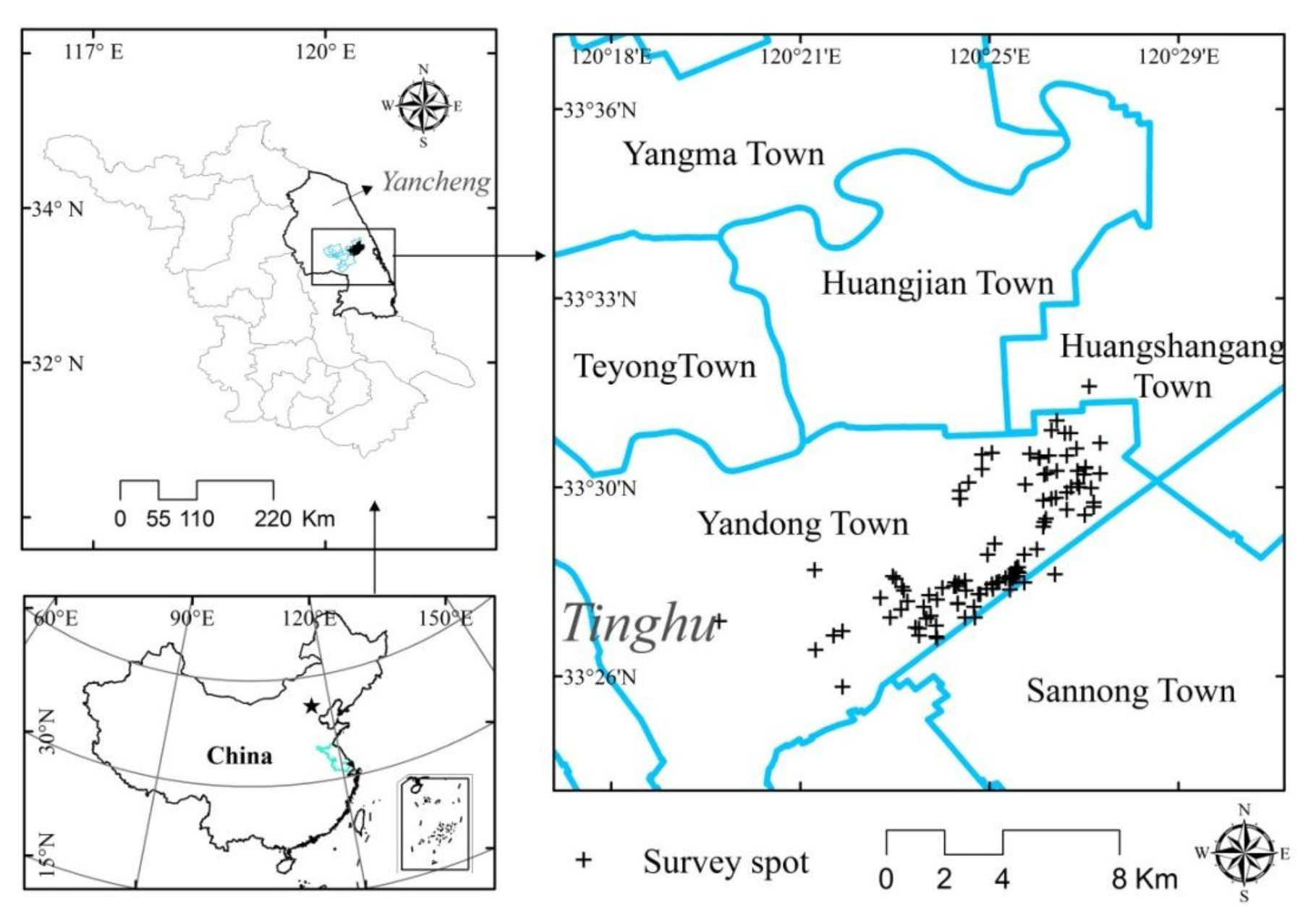
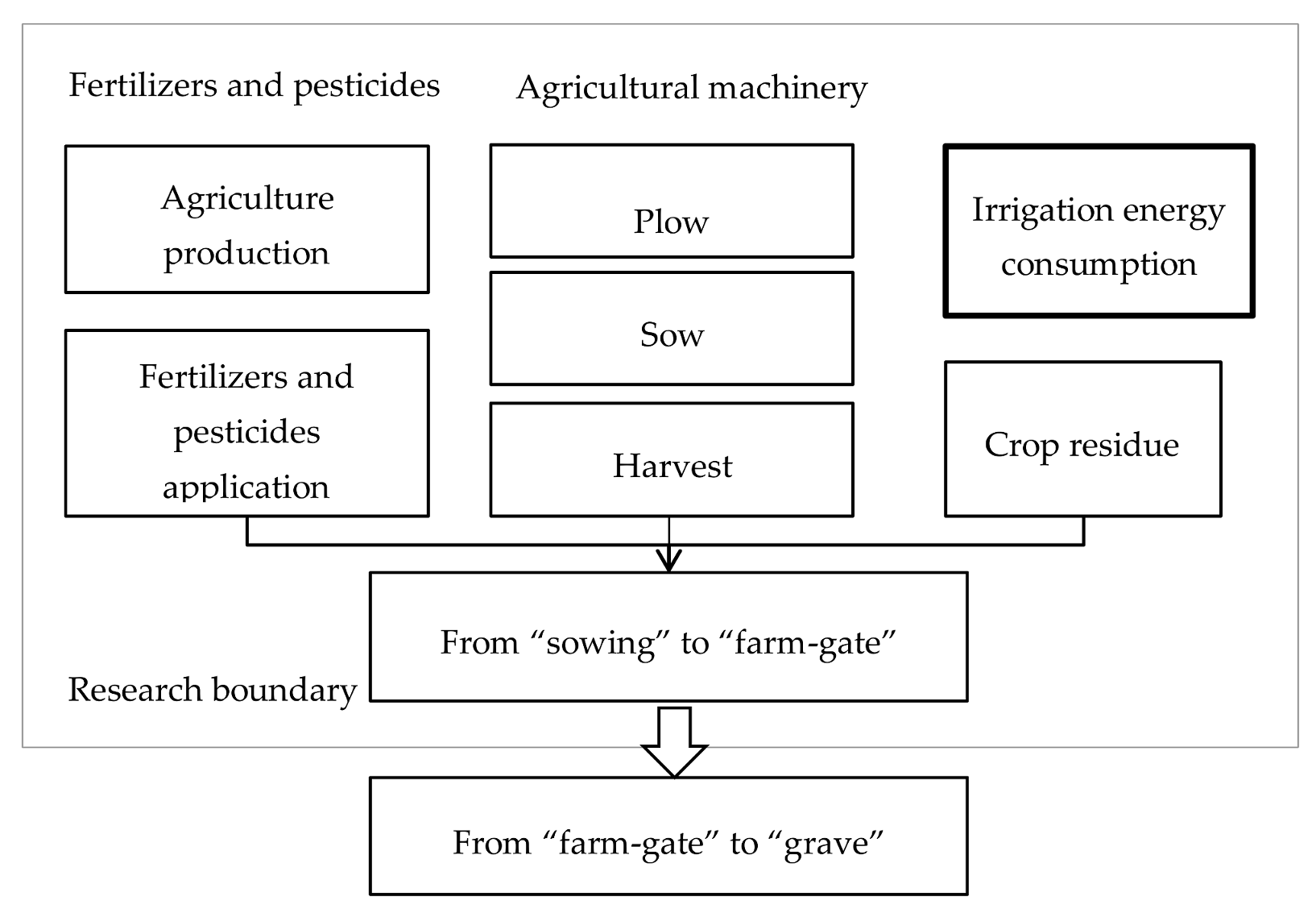

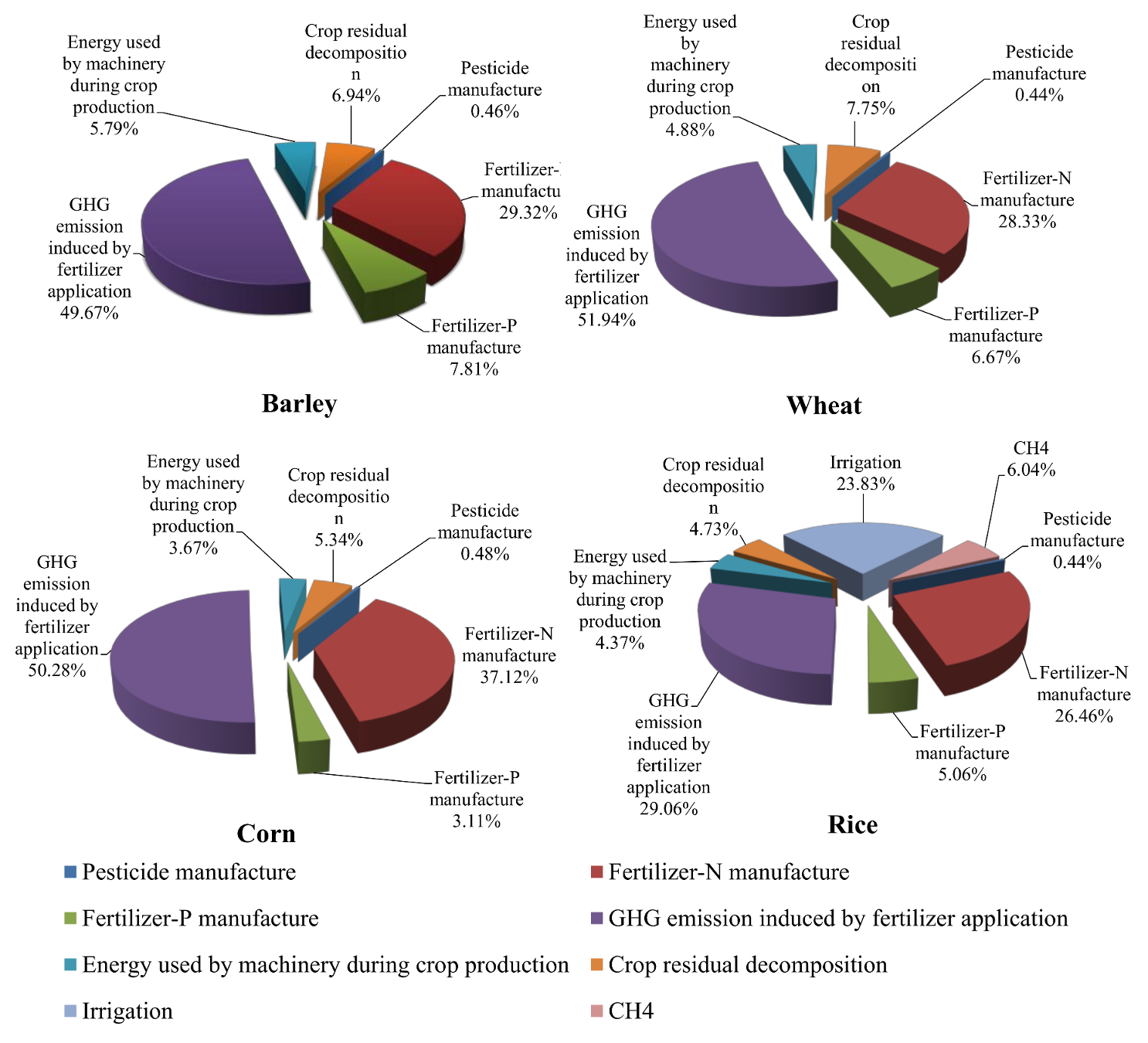
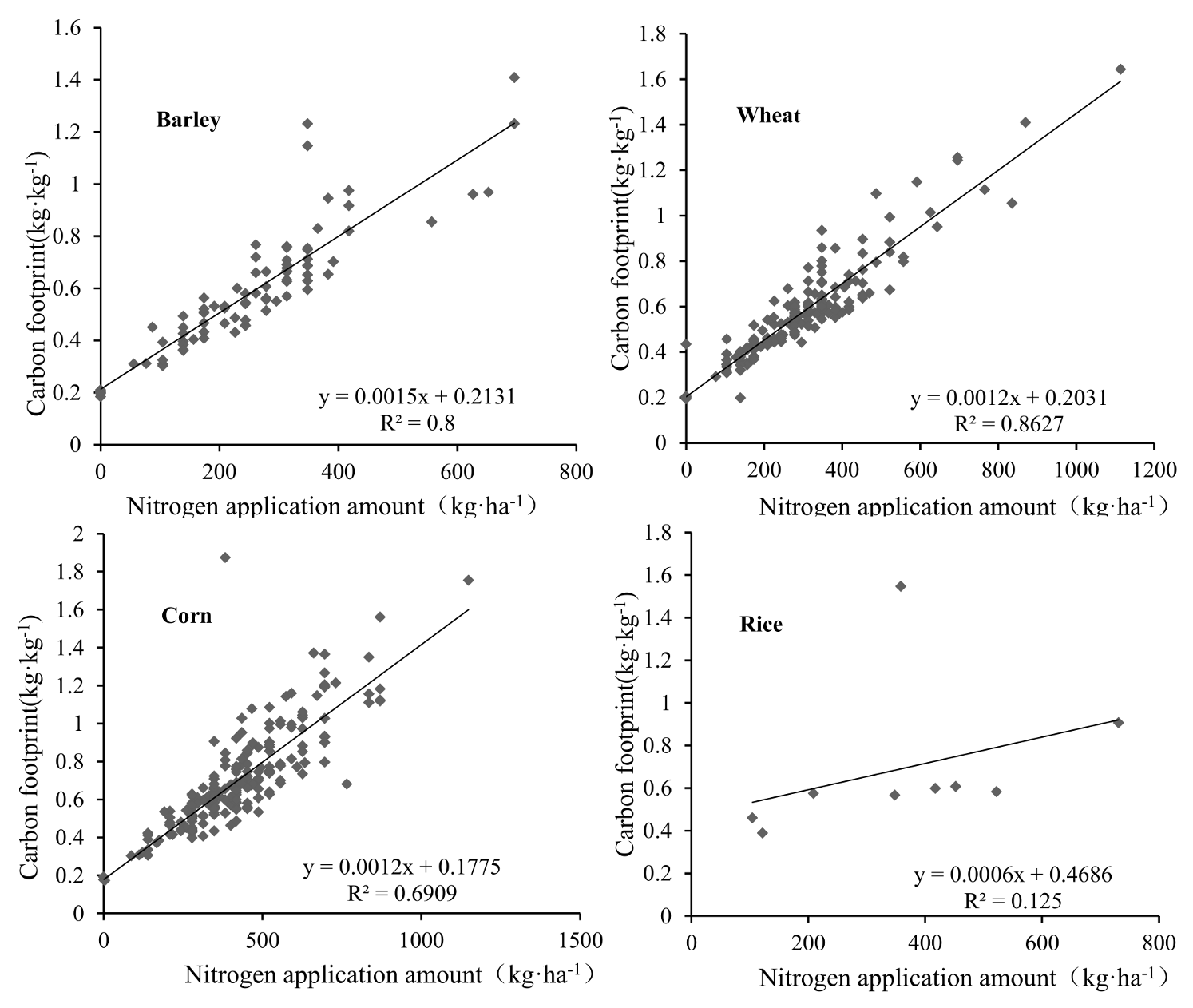
| Age | Reclaimed Years | Farmland Area | SMC | PMC | AHI (million RMB) | |||
|---|---|---|---|---|---|---|---|---|
| >0.1 | 0.05~0.1 | <0.05 | ||||||
| Mean | 58.79 | 45.33 | 8.27 | 8.24% | 68.24% | 2.30% | 4.94% | 82.76% |
| Min | 8.00 | 15.00 | 2.00 | |||||
| Max | 85.00 | 80.00 | 45.00 | |||||
| SD | 9.94 | 22.73 | 4.57 | |||||
| Crop | N Fertilizer (kg) | P Fertilizer (kg) | Pesticides (kg) | Power Consumption (kWh) | Diesel Oil (L) | Grain (kg) | Residuals (kg) |
|---|---|---|---|---|---|---|---|
| Barley | 259.91 ± 107 | 163.41 ± 100 | 1.09 ± 0.25 | — | 82.35 ± 13 | 6451.80 ± 855 | 8387.35 ± 1111 |
| Wheat | 299.49 ± 114 | 166.64 ± 104 | 1.22 ± 0.25 | — | 89.25 ± 11 | 7980.80 ± 1300 | 10,853.89 ± 1769 |
| Corn | 439.28 ± 144 | 80.35 ± 83 | 1.5 ± 0.27 | — | 75.0 ± 10 | 7218.22 ± 1019 | 7940.05 ± 1121 |
| Rice | 362.7 ± 149 | 111.17 ± 113 | 1.39 ± 0.37 | 1569.36 ± 573 | 77.65 ± 3 | 10,499.17 ± 666 | 10,499.17 ± 666 |
| Code | Unit | Value | Reference |
|---|---|---|---|
| WCO2 | — | 1 | [29] |
| WN2O | — | 298 | [29] |
| WCH4 | — | 25 | [29] |
| WCFN | kg·kg−1 | 4.77 | [30] |
| WCFp | kg·kg−1 | 2.02 | [30] |
| WPE | kg·kg−1 | 18.04 | [31] |
| WMA | kg·L−1 | 2.76 | [32] |
| WEL | kg·kWh−1 | 0.943 | [33] |
| WUR | kg·kg−1 | 0.2 | [29] |
| WGR | kg·kg−1 | Barley: 0.035 Wheat: 0.036 Corn: 0.038 Rice: 0.028 | [34] [35] |
| DN | kg·kg−1 | 0.0105 | [29] |
| WNH | kg·kg−1 | 0.01 | [29] |
| L | — | 0.25 | [29] |
| NL | kg·kg−1 | 0.0075 | [29] |
| E(CH4)diff | kg·ha−1·day−1 | 0.150 | [29] |
| Total Carbon Footprint (kg CO2 eq·ha−1) | CO2 Contribution (%) | N2O Contribution (%) | CH4 Contribution (%) | ||
|---|---|---|---|---|---|
| Barley | 3986.87 | 47.32% | 52.68% | 0.00% | |
| Wheat | 4712.48 | 44.41% | 55.59% | 0.00% | |
| Corn | 5344.18 | 46.88% | 53.12% | 0.00% | |
| Rice | 7698.07 | 45.81% | 49.12% | 5.07% |
| Crop | Number of Samples | Per-Yield Carbon Footprint (kg CO2 eq·kg−1) | |||
| Max | Min | Mean | SD | ||
| Barley | 84 | 1.48 | 0.2 | 0.63 | 0.18 |
| Wheat | 181 | 4.61 | 0.22 | 0.64 | 0.18 |
| Corn | 213 | 4.2 | 0.19 | 0.77 | 0.22 |
| Rice | 10 | 1.58 | 0.41 | 0.74 | 0.24 |
| Study Area | Barley | Wheat | Corn | Rice | Reference |
|---|---|---|---|---|---|
| Saline agriculture | 0.630 | 0.636 | 0.769 | 0.739 | This study |
| USA | — | — | 0.390 | — | [39] |
| Korea | — | — | 0.712 | — | [41] |
| Australia | — | 0.15–0.20 | — | — | [40] |
| Japan | — | — | — | 7.7 | [37] |
| Jiangxi, central China | — | — | — | 0.62–1.1 | [26] |
| Shandong, eastern China | — | 0.219–0.426 | 0.563–0.89 | — | [42] |
| Guanzhong plain, Western China | — | — | 0.620 | — | [20] |
| North China plain | — | 0.12 | 0.08 | — | [22] |
| Northeast China | — | — | 0.290 | 0.324 | [24] |
| Fertilizer | Land Preparation | Agrochemicals | Irrigation | Infrastructure | Transportation | Sowing-Harvesting | Packages | Grain Polishing | Grain Boiling | Waste Treatment | |||||
|---|---|---|---|---|---|---|---|---|---|---|---|---|---|---|---|
| N | P | K | Trace Nutrients | Manure | |||||||||||
| Japan [37] | √ | √ | √ | √ | √ | √ | √ | √ | √ | √ | √ | √ | |||
| USA [39] | √ | √ | √ | √ | √ | √ | √ | √ | |||||||
| Korea [41] | √ | √ | √ | √ | √ | √ | √ | ||||||||
| Australia [40] | √ | √ | √ | √ | √ | √ | √ | √ | |||||||
| This study | √ | √ | √ | √ | √ | √ | |||||||||
© 2018 by the authors. Licensee MDPI, Basel, Switzerland. This article is an open access article distributed under the terms and conditions of the Creative Commons Attribution (CC BY) license (http://creativecommons.org/licenses/by/4.0/).
Share and Cite
Li, J.; Yang, W.; Wang, Y.; Li, Q.; Liu, L.; Zhang, Z. Carbon Footprint and Driving Forces of Saline Agriculture in Coastally Reclaimed Areas of Eastern China: A Survey of Four Staple Crops. Sustainability 2018, 10, 928. https://doi.org/10.3390/su10040928
Li J, Yang W, Wang Y, Li Q, Liu L, Zhang Z. Carbon Footprint and Driving Forces of Saline Agriculture in Coastally Reclaimed Areas of Eastern China: A Survey of Four Staple Crops. Sustainability. 2018; 10(4):928. https://doi.org/10.3390/su10040928
Chicago/Turabian StyleLi, Jianguo, Wenhui Yang, Yi Wang, Qiang Li, Lili Liu, and Zhongqi Zhang. 2018. "Carbon Footprint and Driving Forces of Saline Agriculture in Coastally Reclaimed Areas of Eastern China: A Survey of Four Staple Crops" Sustainability 10, no. 4: 928. https://doi.org/10.3390/su10040928




